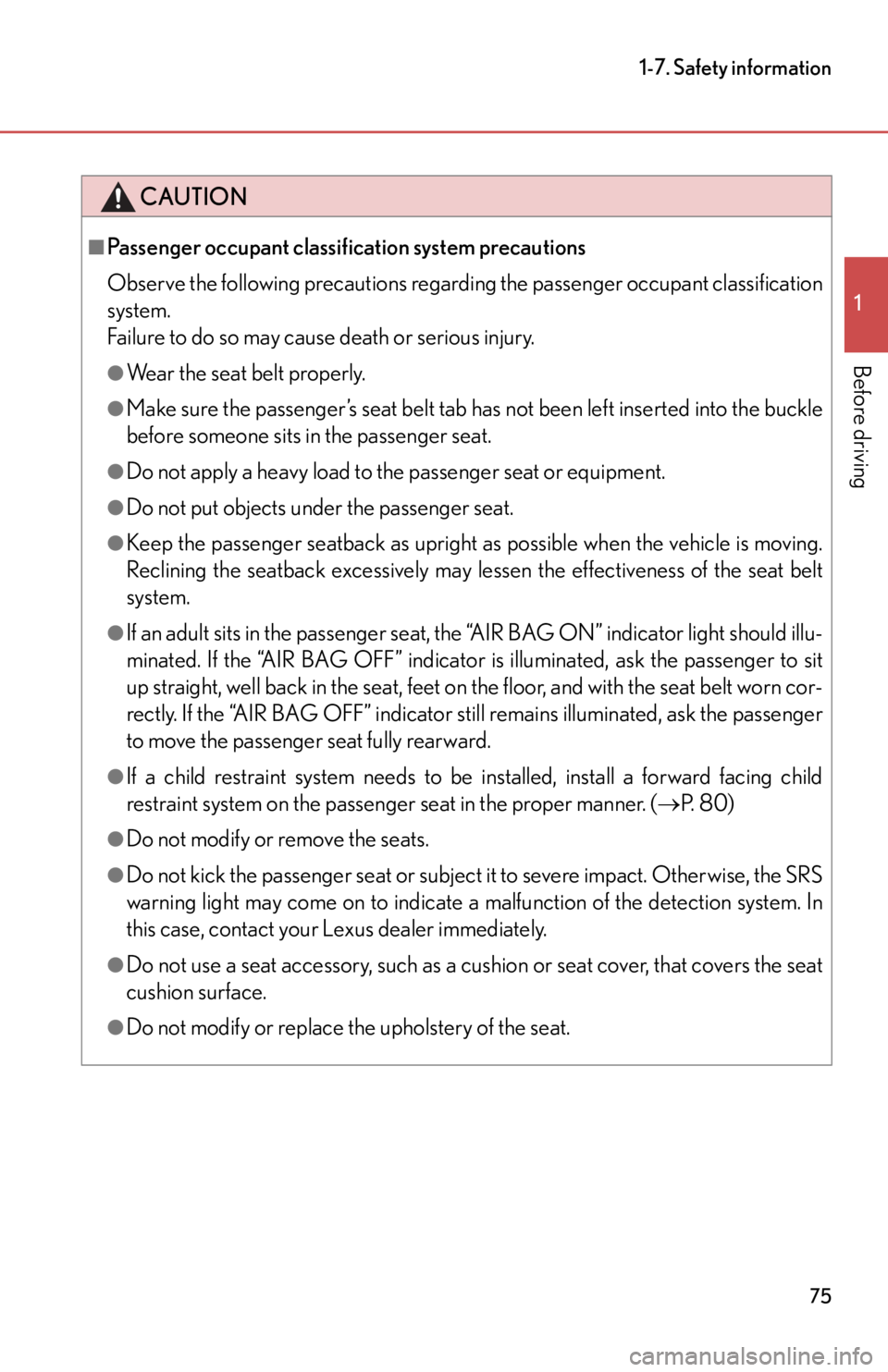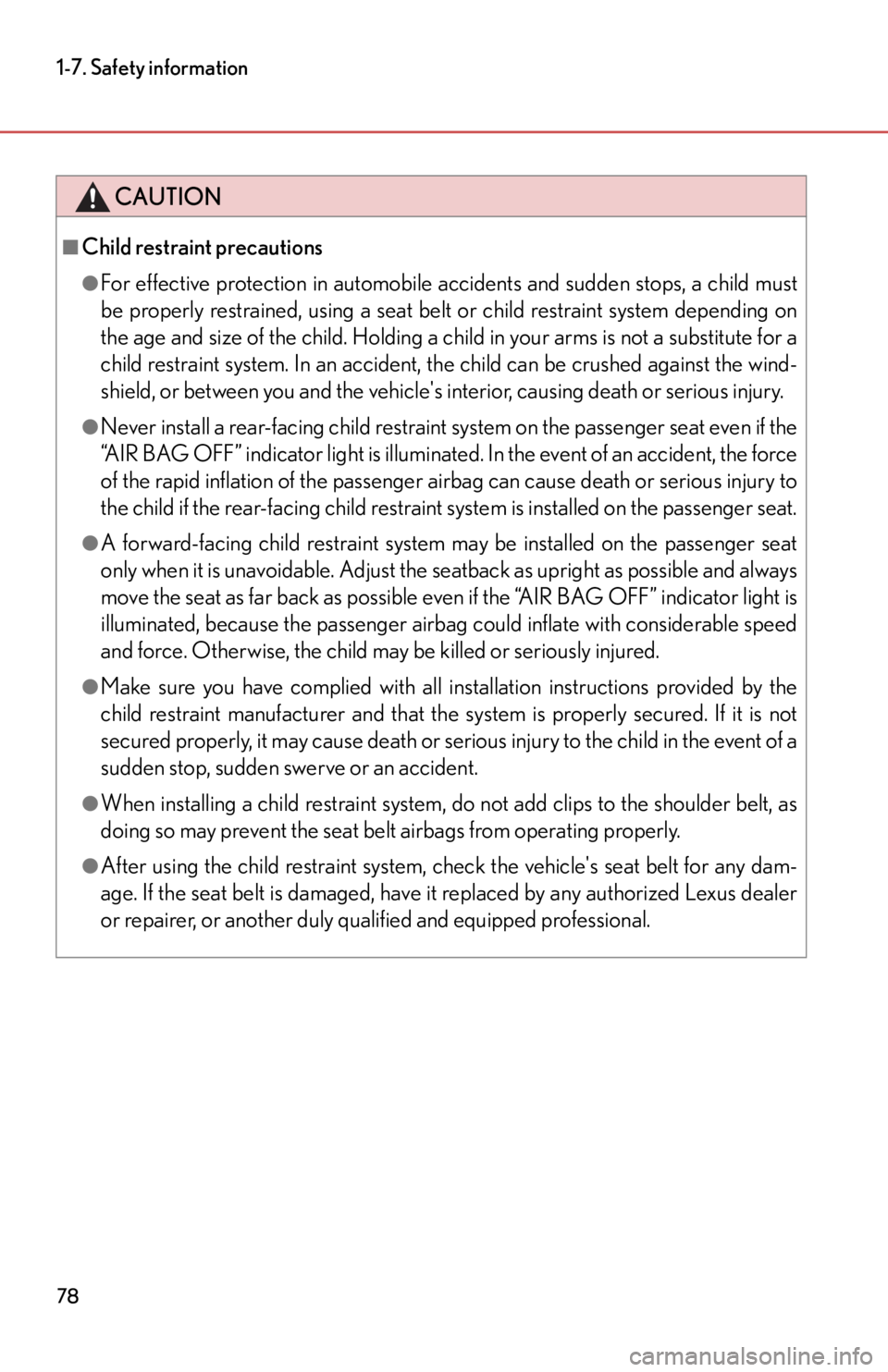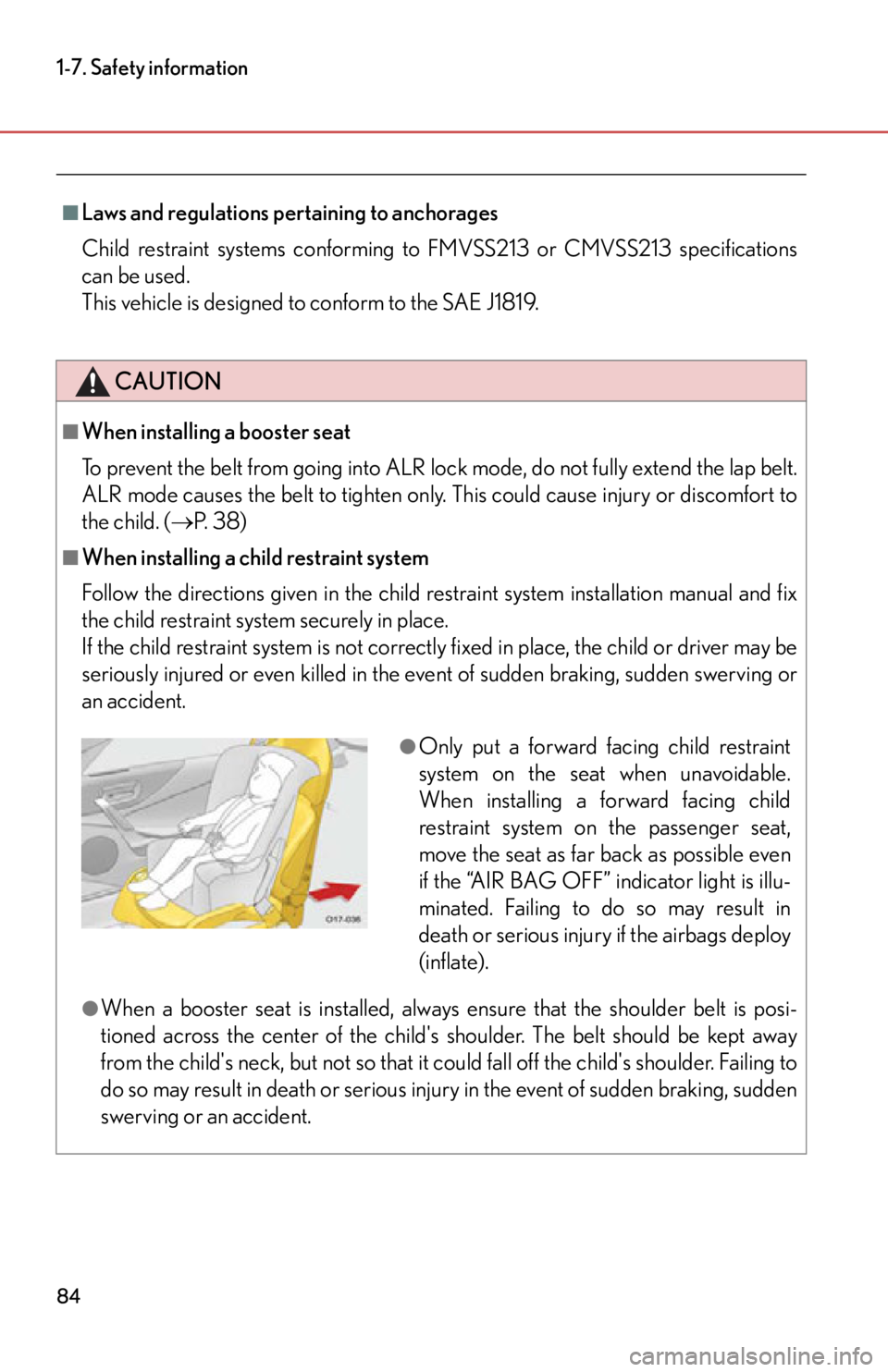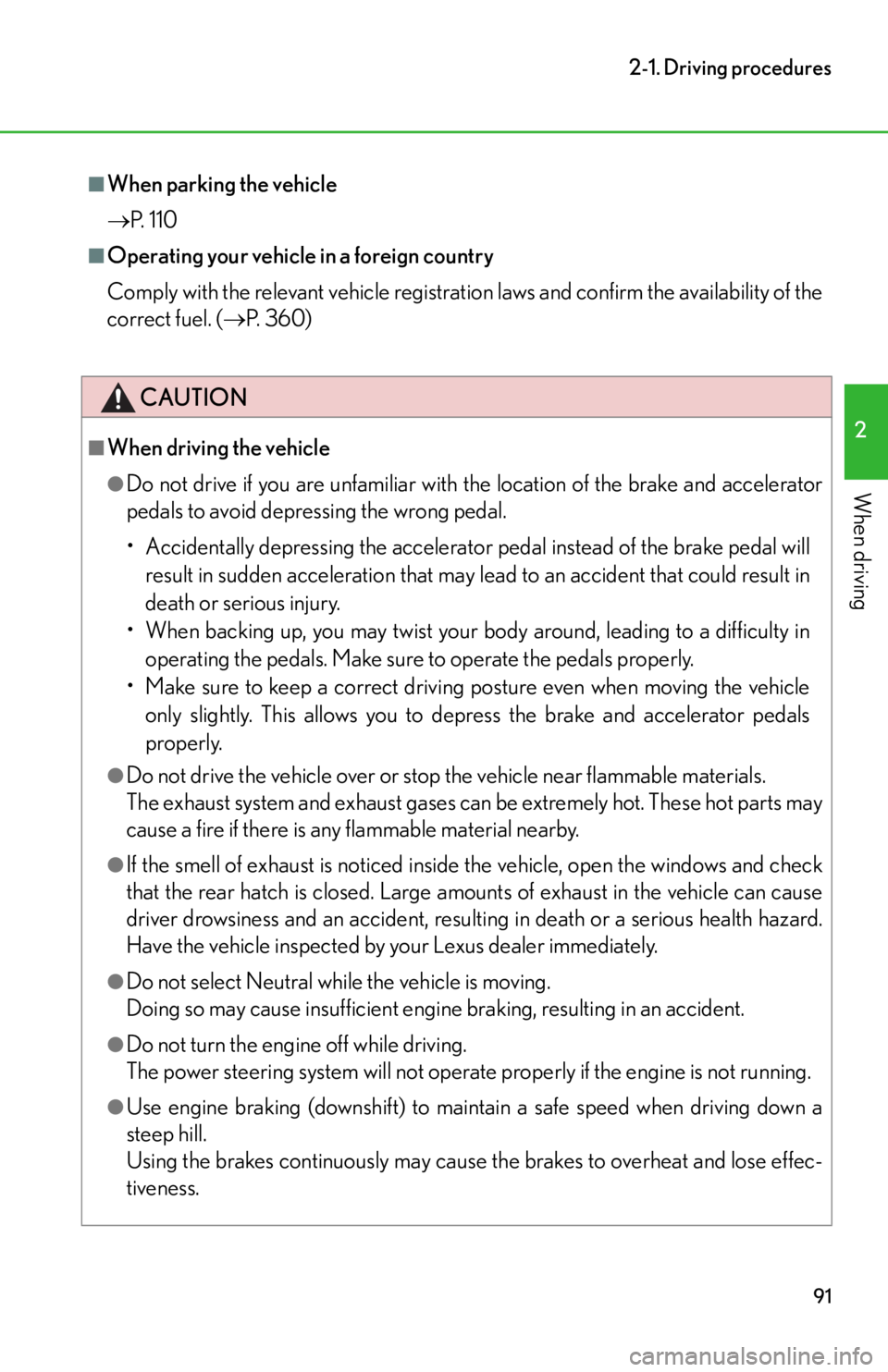Page 74 of 420
72
1-7. Safety information
Passenger occupant classification system
Your vehicle is equipped with a passenger occupant classification system. This
system detects the conditions of the passenger seat and activates or deacti-
vates the devices for the passenger.
SRS warning light
“AIR BAG ON” indicator light
“AIR BAG OFF” indicator light
Passenger’s seat belt reminder light
Page 75 of 420

73
1-7. Safety information
1
Before driving
Condition and operation in the passenger occupant classification system
■Adult*1
■Child *3 or child restraint system*4
■Unoccupied
Indicator/
warning light “AIR BAG ON” and “AIR BAG OFF”
indicator lights “A I R B A G
ON”
SRS warning light Off
Passenger’s seat belt reminder light Flashing
*2
DevicesPassenger airbag
Activated
Seat belt airbag on the passenger seat
Passenger’s seat belt pretensioner
Indicator/
warning light “AIR BAG ON” and “AIR BAG OFF”
indicator lights “A I R B A G
OFF”
*5
SRS warning light Off
Passenger’s seat belt reminder light Flashing
*2
DevicesPassenger airbag
Deactivated
Seat belt airbag on the passenger seat
Passenger’s seat belt pretensioner Activated
Indicator/
warning light “AIR BAG ON” and “AIR BAG OFF”
indicator lights
Not illuminated
SRS warning light Off
Passenger’s seat belt reminder light
Devices Passenger airbag
Deactivated
Seat belt airbag on the passenger seat
Passenger’s seat belt pretensioner
Page 76 of 420

74
1-7. Safety information
■There is a malfunction in the system
*
1: The system judges a person of adult size as an adult. When a smaller adult sits in the passenger seat, the system may recognize him/her as
a child depending on his/her physique and posture.
*
2: In the event the passenger does not wear a seat belt.
*
3: When a larger child who has outgrow n a child restraint system sits in
the passenger seat, the system may recognize him/her as an adult
depending on his/her physique or posture.
*
4: Never install a rear-facing child restraint system on the passenger
seat. If a child restraint system needs to be installed, install a forward
facing child restraint system on the passenger seat. ( P. 76 )
*
5: In case the indicator is not illumina ted, consult this manual on how to
install the child restraint system properly. ( P. 8 0 )
Indicator/
warning light “AIR BAG ON” and “AIR BAG OFF”
indicator lights “A I R B A G
OFF”
SRS warning light On
Passenger’s seat belt reminder light Off
Devices Passenger airbag
Deactivated
Seat belt airbag on the passenger seat
Passenger’s seat belt pretensioner Activated
Page 77 of 420

75
1-7. Safety information
1
Before driving
CAUTION
■Passenger occupant classification system precautions
Observe the following precautions regarding the passenger occupant classification
system.
Failure to do so may cause death or serious injury.
●Wear the seat belt properly.
●Make sure the passenger’s seat belt tab has not been left inserted into the buckle
before someone sits in the passenger seat.
●Do not apply a heavy load to the passenger seat or equipment.
●Do not put objects under the passenger seat.
●Keep the passenger seatback as upright as possible when the vehicle is moving.
Reclining the seatback excessively may le ssen the effectiveness of the seat belt
system.
●If an adult sits in the passenger seat, the “AIR BAG ON” indicator light should illu-
minated. If the “AIR BAG OFF” indicator is illuminated, ask the passenger to sit
up straight, well back in the seat, feet on the floor, and with the seat belt worn cor-
rectly. If the “AIR BAG OFF” indicator still remains illuminated, ask the passenger
to move the passenger seat fully rearward.
●If a child restraint system needs to be installed, install a forward facing child
restraint system on the passenge r seat in the proper manner. (P. 8 0 )
●Do not modify or remove the seats.
●Do not kick the passenger seat or subject it to severe impact. Otherwise, the SRS
warning light may come on to indicate a malfunction of the detection system. In
this case, contact your Lexus dealer immediately.
●Do not use a seat accessory, such as a cushion or seat cover, that covers the seat
cushion surface.
●Do not modify or replace the upholstery of the seat.
Page 80 of 420

78
1-7. Safety information
CAUTION
■Child restraint precautions
●For effective protection in automobile accidents and sudden stops, a child must
be properly restrained, using a seat belt or child restraint system depending on
the age and size of the child. Holding a child in your arms is not a substitute for a
child restraint system. In an accident, th e child can be crushed against the wind-
shield, or between you and the vehicle's interior, causing death or serious injury.
●Never install a rear-facing child restraint system on the passenger seat even if the
“AIR BAG OFF” indicator light is illuminated. In the event of an accident, the force
of the rapid inflation of the passenger ai rbag can cause death or serious injury to
the child if the rear-facing child restraint system is installed on the passenger seat.
●A forward-facing child restraint system may be installed on the passenger seat
only when it is unavoidable. Adjust the seatback as upright as possible and always
move the seat as far back as possible even if the “AIR BAG OFF” indicator light is
illuminated, because the passenger airbag could inflate with considerable speed
and force. Otherwise, the child may be killed or seriously injured.
●Make sure you have complied with all inst allation instructions provided by the
child restraint manufacturer and that the sy stem is properly secured. If it is not
secured properly, it may cause death or seri ous injury to the child in the event of a
sudden stop, sudden swerve or an accident.
●When installing a child restraint system, do not add clips to the shoulder belt, as
doing so may prevent the seat belt airbags from operating properly.
●After using the child restraint system, check the vehicle's seat belt for any dam-
age. If the seat belt is damaged, have it replaced by any authorized Lexus dealer
or repairer, or another duly qualified and equipped professional.
Page 86 of 420

84
1-7. Safety information
■Laws and regulations pertaining to anchorages
Child restraint systems conforming to FMVSS213 or CMVSS213 specifications
can be used.
This vehicle is designed to conform to the SAE J1819.
CAUTION
■When installing a booster seat
To prevent the belt from going into ALR lo ck mode, do not fully extend the lap belt.
ALR mode causes the belt to tighten only. This could cause injury or discomfort to
the child. ( P. 3 8 )
■When installing a child restraint system
Follow the directions given in the child restraint system installation manual and fix
the child restraint system securely in place.
If the child restraint system is not correctl y fixed in place, the child or driver may be
seriously injured or even killed in the ev ent of sudden braking, sudden swerving or
an accident.
●When a booster seat is installed, always ensure that the shoulder belt is posi-
tioned across the center of the child's shoulder. The belt should be kept away
from the child's neck, but not so that it could fall off the child's shoulder. Failing to
do so may result in death or serious inju ry in the event of sudden braking, sudden
swerving or an accident.
●Only put a forward facing child restraint
system on the seat when unavoidable.
When installing a forward facing child
restraint system on the passenger seat,
move the seat as far back as possible even
if the “AIR BAG OFF” in dicator light is illu-
minated. Failing to do so may result in
death or serious injury if the airbags deploy
(inflate).
Page 89 of 420

When driving2
87
2-1. Driving proceduresDriving the vehicle................... 88
Ignition switch ........................... 98
ASG (Automated Sequential Gearbox) .......... 102
Turn signal lever ........................ 112
Parking brake ............................ 113
Horn ............................................. 115
2-2. Instrument cluster Gauges and meters ................. 116
Indicators and warning lights .......................................... 121
Using the menu........................ 124
2-3. Operating the lights and windshield wipers
Headlight switch...................... 158
Windshield wipers and washer ..................................... 160 2-4. Using other driving
systems
Rear view monitor system .... 163
Driving assist systems ............ 166
Active rear wing ........................ 171
Launch control.......................... 174
2-5. Driving information Cargo and luggage ................. 176
Vehicle load limits .................... 179
Winter driving tips .................. 180
Trailer towing ........................... 182
Dinghy towing .......................... 183
Page 93 of 420

91
2-1. Driving procedures
2
When driving
■When parking the vehicle
P. 1 1 0
■Operating your vehicle in a foreign country
Comply with the relevant vehicle registration laws and confirm the availability of the
correct fuel. ( P. 3 6 0 )
CAUTION
■When driving the vehicle
●Do not drive if you are unfamiliar with the location of the brake and accelerator
pedals to avoid depressing the wrong pedal.
• Accidentally depressing the accelerato r pedal instead of the brake pedal will
result in sudden acceleration that may le ad to an accident that could result in
death or serious injury.
• When backing up, you may twist your bo dy around, leading to a difficulty in
operating the pedals. Make sure to operate the pedals properly.
• Make sure to keep a correct driving posture even when moving the vehicle
only slightly. This allows you to depress the brake and accelerator pedals
properly.
●Do not drive the vehicle over or stop the vehicle near flammable materials.
The exhaust system and exhaust gases can be extremely hot. These hot parts may
cause a fire if there is any flammable material nearby.
●If the smell of exhaust is noticed inside the vehicle, open the windows and check
that the rear hatch is closed. Large amounts of exhaust in the vehicle can cause
driver drowsiness and an accident, resulting in death or a serious health hazard.
Have the vehicle inspected by your Lexus dealer immediately.
●Do not select Neutral while the vehicle is moving.
Doing so may cause insufficient engine braking, resulting in an accident.
●Do not turn the engine off while driving.
The power steering system will not operate properly if the engine is not running.
●Use engine braking (downshift) to maintain a safe speed when driving down a
steep hill.
Using the brakes continuously may cause the brakes to overheat and lose effec-
tiveness.